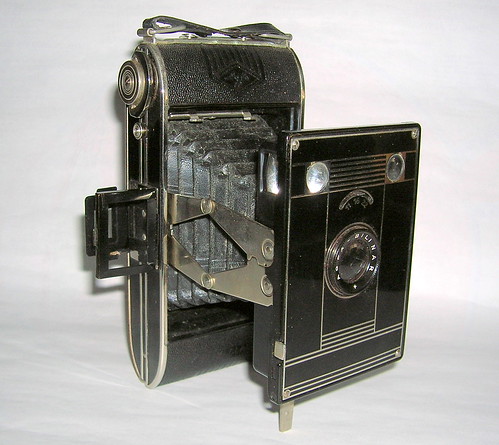Difference between revisions of "Agfa Billy-Clack"
Hanskerensky (talk | contribs) (Added image author and rights) |
(Rewrite.) |
||
| Line 8: | Line 8: | ||
|image_rights= with permission | |image_rights= with permission | ||
}} | }} | ||
| − | + | The '''Billy-Clack''' is either of two strut-folding cameras made by Agfa from about 1934 to 1940.<ref name=McK>{{McKeown12}} p.18</ref> There are two models, for different formats. The name 'Clack' was used for simple cameras made by [[Rietzschel]] before they and Agfa merged (in the creation of IG Farben).<ref name=MG>[http://mgroleau.com/photo/allemagne/agfa/agfa_clack.html Billy-Clack] page, with several pictures, at [http://mgroleau.com/index.html Mario Groleau's website].</ref> In some countries they were sold with the name Speedex. | |
| − | |||
| − | + | ===Billy-Clack No. 51=== | |
| + | The '''Billy-Clack No. 51''' (or Speedex No. 51) takes sixteen 4.5×6 cm pictures on 120 film. It has an f/8.8 Igestar lens ('Jgestar'; the name probably refers to Agfa's being part of IG Farben), with three aperture settings (f/8.8, f/11 and f/16, which are achieved by switching between fixed-size apertures, not with an iris); the aperture control is below the lens on the No. 51, not above it, as on the camera pictured. It has a simple 'I' and 'B' shutter. It has [[brilliant finder]]s for landscape and portrait orientation. It has a built-in yellow filter,<ref name=McK></ref> put in place by a pull-tab on the side of the front panel. | ||
| − | + | Early examples have conventional leatherette covering;<ref name=CdA>[http://www.collection-appareils.fr/agfa/html/billy_clack.php Billy-Clack No. 51] with leatherette covering, at Sylvain Halgand's [http://www.collection-appareils.fr/general/html/francais.php Collection d'Appareils].</ref> McKeown states that cameras made from 1938 onward are covered with ''Robusit'' herringbone-textured covering (the examples pictured in McKeown and on Mario Groleau's site have this covering).<ref name=McK></ref><ref name=MG></ref> | |
| − | == | + | ===Billy-Clack No. 74=== |
| − | + | The '''Billy-Clack No. 74''' takes eight 6×9 cm pictures on 120 film. It has an f/11 Bilinar lens, with aperture settings for f/16 and f/22, again by switching between fixed-size apertures. Like the No. 51, it has an 'I' and 'B' shutter and brilliant finders for both orientations. It also has a folding frame finder on the camera body. Instead of the yellow filter, McKeown states that this camera has a portrait lens, operated by the metal tab on the right of the front panel.<ref name=McK></ref> Again, early examples are covered with leatherette, as pictured here, and later ones have herringbone covering. | |
| − | + | ===Notes=== | |
| + | <references /> | ||
| + | |||
| + | [[Category: 4.5x6 strut folding]] | ||
| + | [[Category: 6x9 strut folding]] | ||
| + | [[Category: German 4.5x6 viewfinder folding]] | ||
[[Category:German 6x9 viewfinder folding]] | [[Category:German 6x9 viewfinder folding]] | ||
[[Category: B|Billy-Clack]] | [[Category: B|Billy-Clack]] | ||
[[Category: Agfa|Billy-Clack]] | [[Category: Agfa|Billy-Clack]] | ||
| − | |||
Revision as of 08:42, 29 August 2011

|
| Agfa Billy Clack 74 image by jgs4309976 (Image rights) |
The Billy-Clack is either of two strut-folding cameras made by Agfa from about 1934 to 1940.[1] There are two models, for different formats. The name 'Clack' was used for simple cameras made by Rietzschel before they and Agfa merged (in the creation of IG Farben).[2] In some countries they were sold with the name Speedex.
Billy-Clack No. 51
The Billy-Clack No. 51 (or Speedex No. 51) takes sixteen 4.5×6 cm pictures on 120 film. It has an f/8.8 Igestar lens ('Jgestar'; the name probably refers to Agfa's being part of IG Farben), with three aperture settings (f/8.8, f/11 and f/16, which are achieved by switching between fixed-size apertures, not with an iris); the aperture control is below the lens on the No. 51, not above it, as on the camera pictured. It has a simple 'I' and 'B' shutter. It has brilliant finders for landscape and portrait orientation. It has a built-in yellow filter,[1] put in place by a pull-tab on the side of the front panel.
Early examples have conventional leatherette covering;[3] McKeown states that cameras made from 1938 onward are covered with Robusit herringbone-textured covering (the examples pictured in McKeown and on Mario Groleau's site have this covering).[1][2]
Billy-Clack No. 74
The Billy-Clack No. 74 takes eight 6×9 cm pictures on 120 film. It has an f/11 Bilinar lens, with aperture settings for f/16 and f/22, again by switching between fixed-size apertures. Like the No. 51, it has an 'I' and 'B' shutter and brilliant finders for both orientations. It also has a folding frame finder on the camera body. Instead of the yellow filter, McKeown states that this camera has a portrait lens, operated by the metal tab on the right of the front panel.[1] Again, early examples are covered with leatherette, as pictured here, and later ones have herringbone covering.
Notes
- ↑ 1.0 1.1 1.2 1.3 McKeown, James M. and Joan C. McKeown's Price Guide to Antique and Classic Cameras, 12th Edition, 2005-2006. USA, Centennial Photo Service, 2004. ISBN 0-931838-40-1 (hardcover). ISBN 0-931838-41-X (softcover). p.18
- ↑ 2.0 2.1 Billy-Clack page, with several pictures, at Mario Groleau's website.
- ↑ Billy-Clack No. 51 with leatherette covering, at Sylvain Halgand's Collection d'Appareils.